Search Result
Results for "
Insulin resistance
" in MedChemExpress (MCE) Product Catalog:
2
Biochemical Assay Reagents
2
Isotope-Labeled Compounds
| Cat. No. |
Product Name |
Target |
Research Areas |
Chemical Structure |
-
- HY-147392
-
|
|
CXCR
|
Metabolic Disease
|
|
CXCR2 antagonist 8 is a potent and selective CXCR2 antagonist. CXCR2 antagonist 8 can be used for insulin resistance research .
|
-
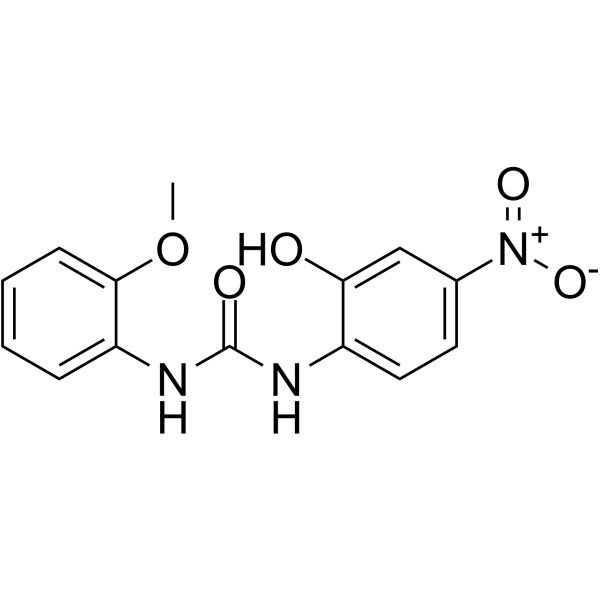
-
- HY-W018499
-
|
|
Endogenous Metabolite
|
Others
|
|
(S)-2-Hydroxybutanoic acid is the S-enantiomer of 2-Hydroxybutanoic acid. 2-Hydroxybutanoic acid, a coproduct of protein metabolism, is an insulin resistance (IR) biomarker .
|
-

-
- HY-P3580A
-
|
Human N-acetyl GIP TFA
|
Insulin Receptor
|
Metabolic Disease
Endocrinology
|
|
Acetyl Gastric Inhibitory Peptide (human) TFA is a fatty acid derivatized analog of glucose-dependent insulinotropic polypeptide with improved antihyperglycaemic and insulinotropic properties. Acetyl Gastric Inhibitory Peptide (human) TFA can be used for research of diabetes, insulin resistance and obesity .
|
-

-
- HY-117830
-
|
|
Phosphatase
|
Endocrinology
|
|
CX08005 is a competitive PTP1B inhibitor. CX08005 can directly enhance the action of insulin in vivo and in vitro and improve insulin resistance .
|
-
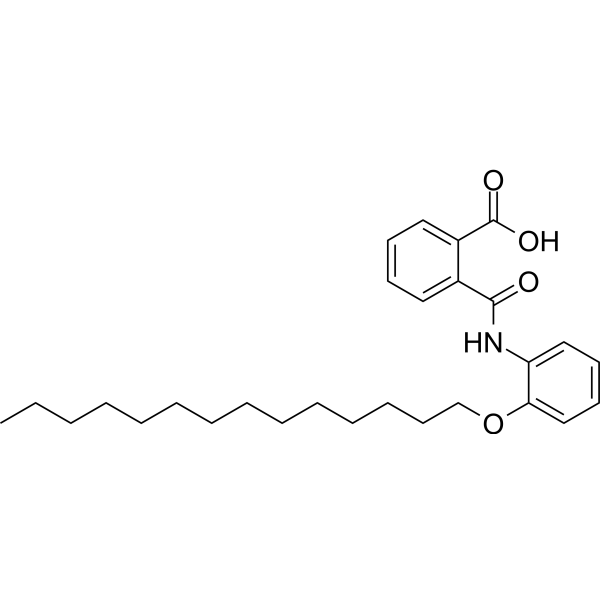
-
- HY-P3580
-
|
Human N-acetyl GIP
|
Insulin Receptor
|
Metabolic Disease
Endocrinology
|
|
Acetyl Gastric Inhibitory Peptide (human) is a fatty acid derivatized analog of glucose-dependent insulinotropic polypeptide with improved antihyperglycaemic and insulinotropic properties. Acetyl Gastric Inhibitory Peptide (human) can be used for research of diabetes, insulin resistance and obesity .
|
-

-
- HY-108022A
-
|
MSDC-0602K
|
Insulin Receptor
PPAR
|
Metabolic Disease
|
|
Azemiglitazone potassium (MSDC-0602K), a PPARγ-sparing thiazolidinedione (Ps-TZD), binds to PPARγ with the IC50 of 18.25 μM . Azemiglitazone potassium modulates the mitochondrial pyruvate carrier (MPC). Azemiglitazone potassium can be used for the research of fatty liver including dysfunctional lipid metabolism, inflammation, and insulin resistance . Azemiglitazone potassium, an insulin sensitizer, improves insulinemia and fatty liver disease in mice, alone and in combination with Liraglutide .
|
-

-
- HY-161321
-
|
|
Phosphatase
Insulin Receptor
Akt
|
Metabolic Disease
|
|
PTP1B-IN-24 (Compound 9) is a reversible PTP1B inhibitor with an IC50 value of 1.4 μM, and PTP1B-IN-24 can enhance the thermal stability of PTP1B. PTP1B-IN-24 can restore PA- (HY-N0830) induced insulin resistance by increasing the phosphorylation levels of IRS1 and AKT .
|
-
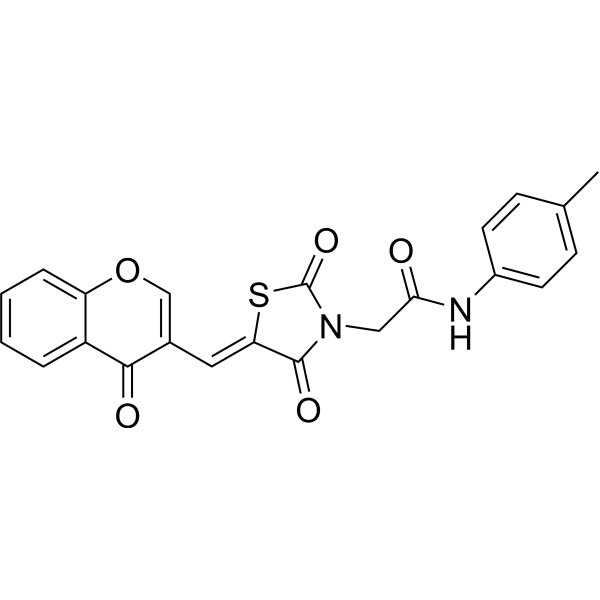
-
- HY-148598
-
|
CUR5-8
|
Apoptosis
Autophagy
|
Metabolic Disease
|
|
Curcumin 5-8 (CUR5-8) is a potent and orally active naturally active curcumin (CUR) analog. Curcumin 5-8 inhibits lipid droplet formation. Curcumin 5-8 increases autophagy and inhibits Apoptosis. Curcumin 5-8 improves insulin resistance and insulin sensitivity .
|
-

-
- HY-N2953
-
|
|
Fatty Acid Synthase (FASN)
|
Metabolic Disease
|
|
Borapetoside E can be isolated from T. crispa. Borapetoside E improves hyperglycemia, insulin resistance, hepatic steatosis, hyperlipidemia, and oxygen consumption in obese mice. Borapetoside E also inhibits SREBPs expression in the liver and adipose tissue .
|
-

-
- HY-N10405
-
|
|
Keap1-Nrf2
|
Metabolic Disease
|
|
(R)-5-Hydroxy-1,7-diphenyl-3-heptanone is a diarylheptanoid that can be found in Alpinia officinarum. (R)-5-Hydroxy-1,7-diphenyl-3-heptanone ameliorates oxidative stress and insulin resistance via activation of Nrf2/ARE pathway .
|
-
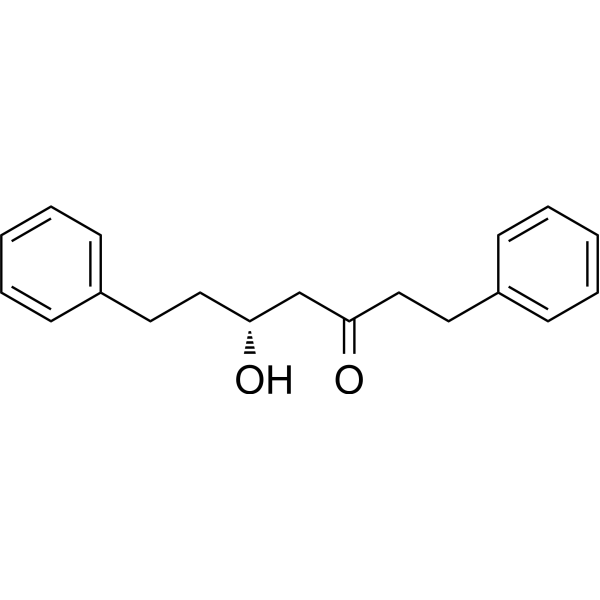
-
- HY-N7073
-
|
|
SARS-CoV
|
Infection
Neurological Disease
Inflammation/Immunology
Cancer
|
|
Silymarin is an extract of the milk thistle (Silybum marianum). Silymarin is an effective SARS-CoV-2 main protease (M pro) inhibitor. Silymarin can significantly reduce tumor cell proliferation, angiogenesis as well as insulin resistance. Silymarin has the chemopreventive effect on hepatocellular carcinoma (HCC). Silymarin has the potential for COVID-19 research .
|
-

-
- HY-B0384
-
|
|
Angiotensin-converting Enzyme (ACE)
|
Cardiovascular Disease
|
|
Temocapril hydrochloride is an orally active angiotensin-converting enzyme (ACE) inhibitor. Temocapril hydrochloride can be used for the research of hypertension, congestive heart failure, acute myocardial infarction, insulin resistance, and renal diseases .
|
-
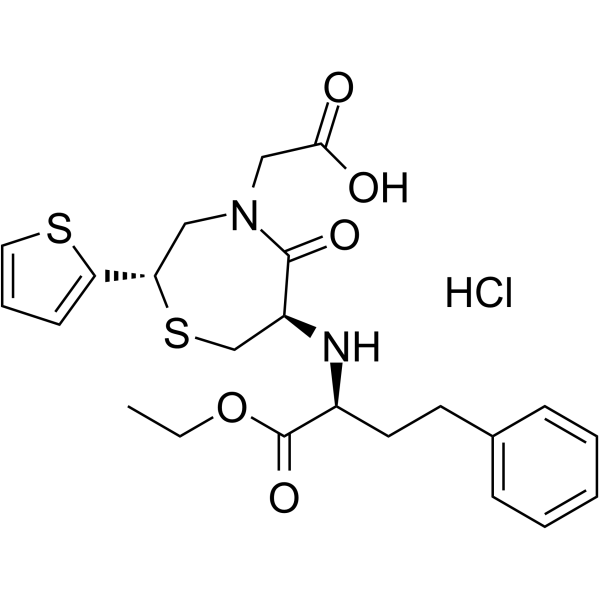
-
- HY-100713
-
|
|
Angiotensin-converting Enzyme (ACE)
|
Cardiovascular Disease
|
|
Temocapril is an orally active angiotensin-converting enzyme (ACE) inhibitor. Temocapril can be used for the research of hypertension, congestive heart failure, acute myocardial infarction, insulin resistance, and renal diseases .
|
-
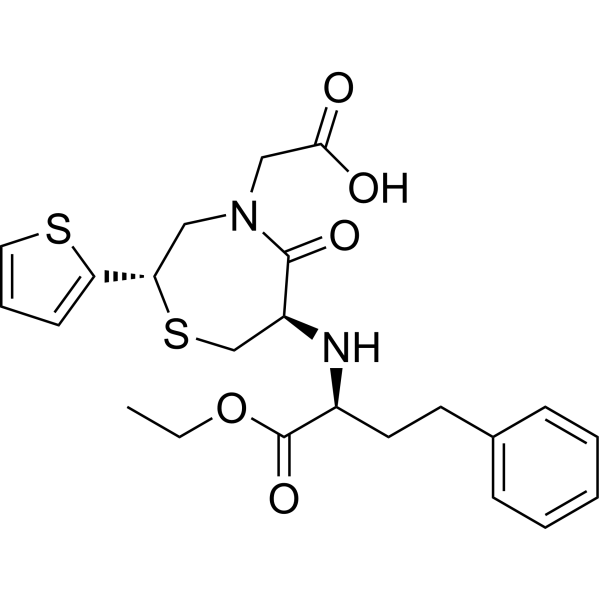
-
- HY-153335
-
|
|
Phosphodiesterase (PDE)
|
Infection
Cardiovascular Disease
Metabolic Disease
Inflammation/Immunology
Cancer
|
|
Enpp-1-IN-16 (compound 54) is an ENPP1 inhibitor. Enpp-1-IN-16 has the potential to study cancer, especially in cases of high ENPP1 expression or elevated cytoplasmic DNA levels. Enpp-1-IN-16 can also be used in other diseases mediated by ENPP1, such as bacterial or viral infections, insulin resistance and type II diabetes, chondrocalcinosis and osteoarthritis, calcium pyrophosphate deposition disorder (CPPD), low Phosphatase disease and soft tissue calcification disorders .
|
-

-
- HY-N0457
-
|
Cichoric acid; Dicaffeoyltartaric acid
|
Reactive Oxygen Species
Apoptosis
|
Metabolic Disease
Inflammation/Immunology
|
|
Chicoric acid (Cichoric acid), an orally active dicaffeyltartaric acid, induces reactive oxygen species (ROS) generation. Chicoric acid inhibits cell viability and induces mitochondria-dependent apoptosis in 3T3-L1 preadipocytes through ROS-mediated PI3K/Akt and MAPK signaling pathways. Chicoric acid increases glucose uptake, improves insulin resistance, and attenuates glucosamine-induced inflammation. Chicoric acid has antidiabetic properties and antioxidant, anti-inflammatory effects .
|
-

-
- HY-126833B
-
|
14:0 Coenzyme A
|
Others
|
Metabolic Disease
|
|
Myristoyl coenzyme A triammonium (14:0 Coenzyme A) is a type of long-chain acyl-CoA, which is the activated form of long-chain fatty acids and serves as a crucial lipid metabolite .
|
-
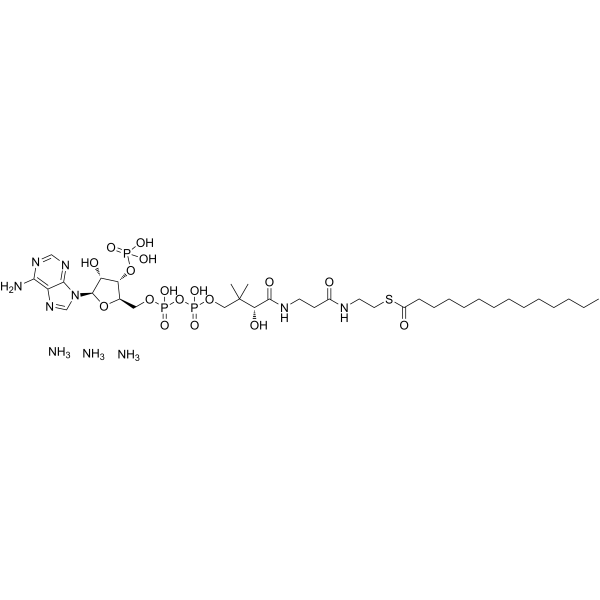
-
- HY-N9410
-
|
1-Linoleoyl-2-Hydroxy-sn-glycero-3-PC
|
Endogenous Metabolite
|
Metabolic Disease
|
|
Lysophosphatidylcholine 18:2 (1-Linoleoyl-2-Hydroxy-sn-glycero-3-PC), a lysophospholipid, is a potential biomarker identified from insulin resistance (IR) polycystic ovary syndrome (PCOS). Low plasma Lysophosphatidylcholine 18:2 also has been shown to predict impaired glucose tolerance, insulin resistance, type 2 diabetes, coronary artery disease, and memory impairment .
|
-
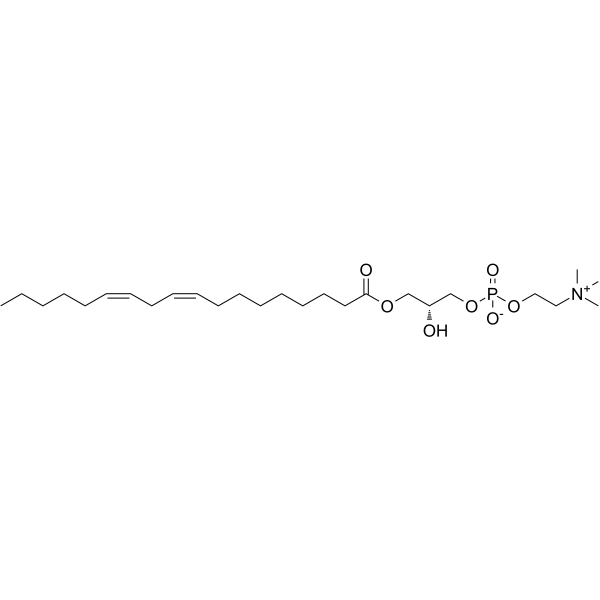
-
- HY-N4244
-
|
|
Reactive Oxygen Species
|
Inflammation/Immunology
|
|
Kakkalide is an isoflavone derived from the flowers of Pueraria lobata. Kakkalide ameliorates endothelial insulin resistance by suppressing reactive oxygen species (ROS)-associated inflammation .
|
-
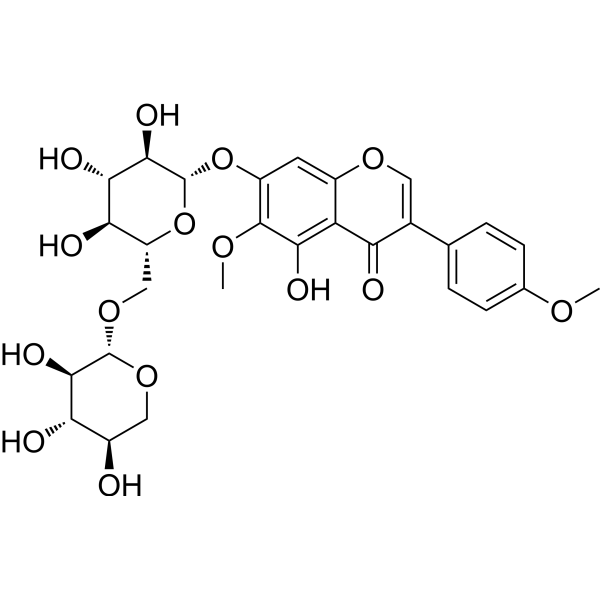
-
- HY-156876
-
|
|
Others
|
Metabolic Disease
|
|
GPR75 antagonist-2 is an antagonist of GPR75. GPR75 antagonist-2 can used in study obesity and insulin resistance .
|
-
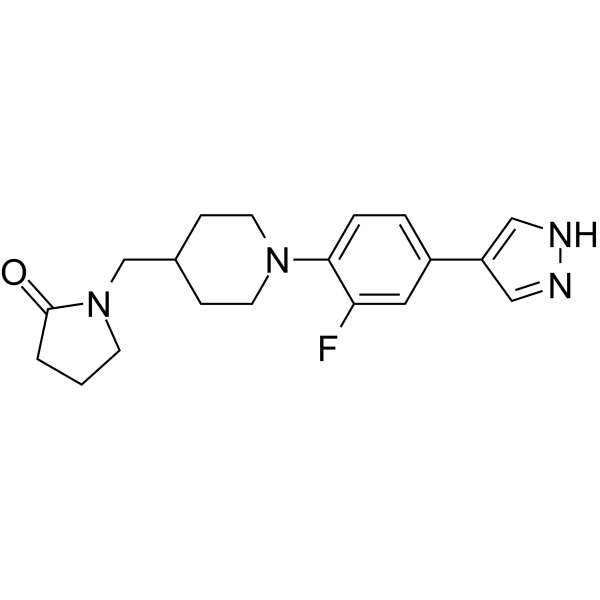
-
- HY-N1995
-
|
|
|
|
|
Methylswertianin is an active constituent in Swertia punicea Hemsl, with anti-diabetic effect. Methylswertianin can abates type-2 diabetes, likely via the improvement of insulin resistance (IR) .
|
-
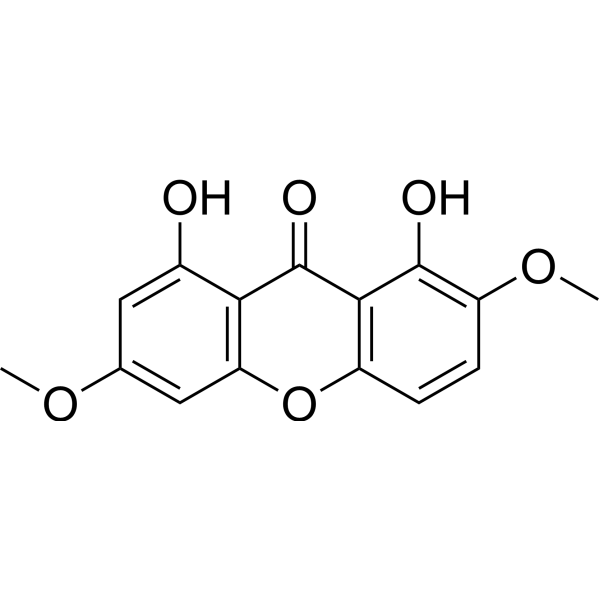
-
- HY-N3021
-
|
|
Endogenous Metabolite
|
Metabolic Disease
|
|
D-chiro-Inositol is an epimer of myo-inositol found in certain mammalian glycosylphosphatidylinositol protein anchors and inositol phosphoglycans possessing insulin-like bioactivity. D-chiro-Inositol is used clinically for the treatment of polycystic ovary syndrome (PCOS) and diabetes mellitus, which can reduce hyperglycemia and ameliorate insulin resistance .
|
-
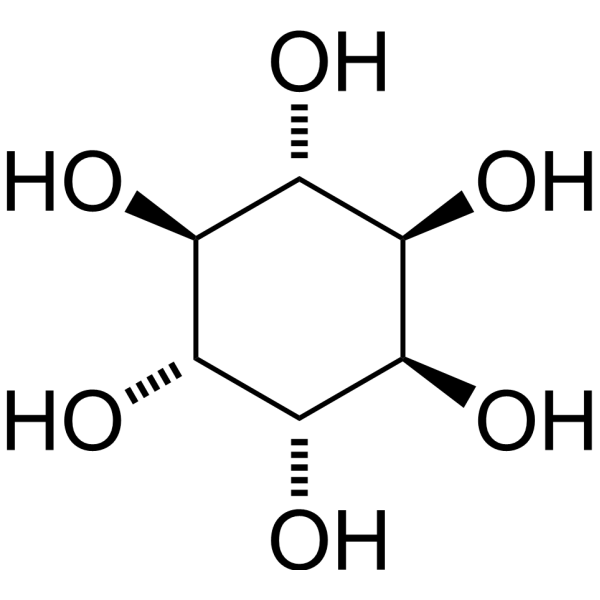
-
- HY-N2936
-
|
|
Others
|
Others
|
|
Bi-linderone is isolated as racemate from the traditional Chinese medicinal plant Lindera aggregata. Bi-linderone has activity against glucosamine-induced insulin resistance in HepG2 cells at a concentration of 1 μg/mL .
|
-
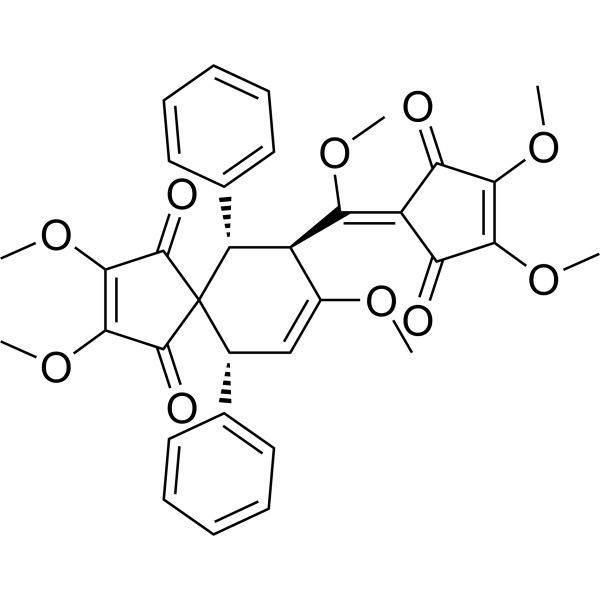
-
- HY-N12670
-
-

-
- HY-N1419
-
|
|
|
|
|
Vaccarin is an active flavonoid glycoside associated with various biological functions. Vaccarin significantly promote wound healing and endothelial cells and fibroblasts proliferation in the wound site. Vaccarin ameliorates insulin resistance and steatosis by activating the AMPK signaling pathway .
|
-

-
- HY-100713S
-
-
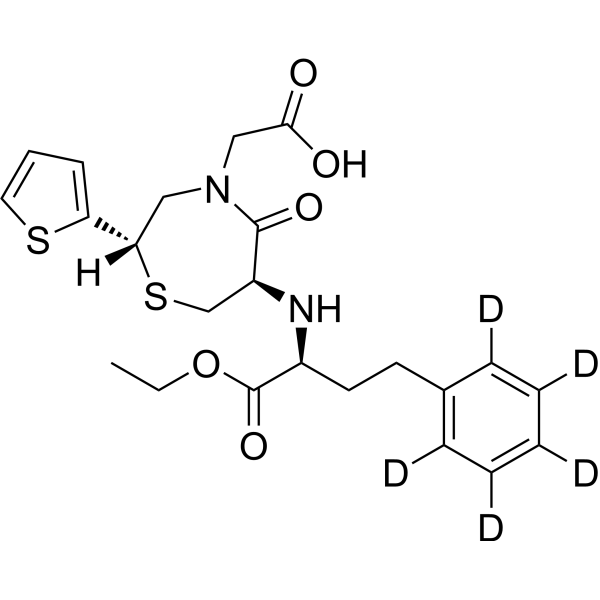
-
- HY-B1245
-
|
Salicylsalicylic acid; Disalicylic acid
|
Reactive Oxygen Species
|
Inflammation/Immunology
|
|
Salsalate, a non-acetylated salicylate, is an effective antirheumatic agent that bypasses gastric absorption and also avoids cyclooxygenase inhibition. Salsalate has anti-inflammatory activity and reduces glucose levels, insulin resistance, and cytokine expression. Salsalate can be used in the research of type 2 diabetes .
|
-
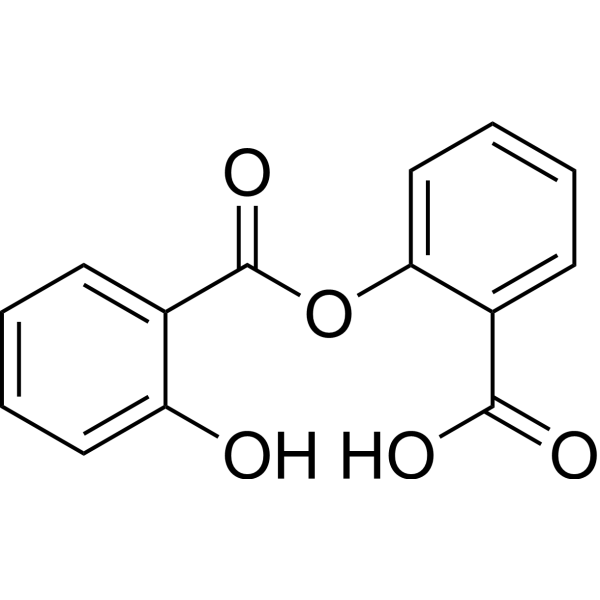
-
- HY-N3542
-
|
|
Glucosidase
|
Cancer
|
|
Carpachromene is a potent α-glucosidase enzyme inhibitor. Carpachromene ameliorates insulin resistance in HepG2 cells via modulating IR/IRS1/PI3k/Akt/GSK3/FoxO1 pathway .
|
-
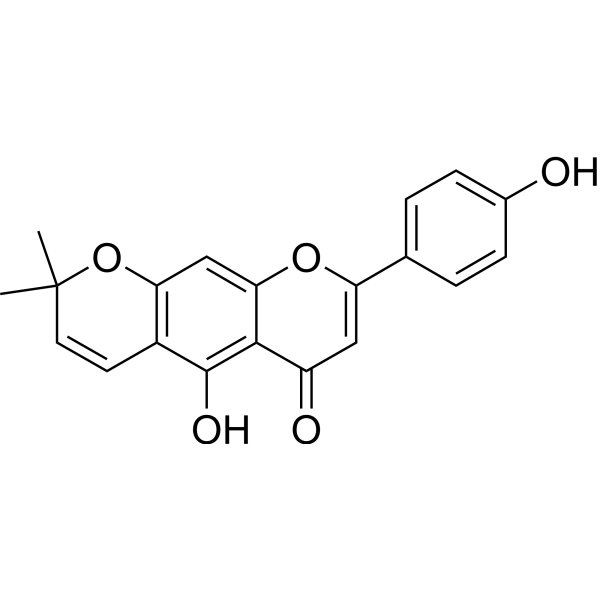
-
- HY-N9410S
-
|
1-Linoleoyl-2-Hydroxy-sn-glycero-3-PC-d9
|
Isotope-Labeled Compounds
Endogenous Metabolite
|
Metabolic Disease
|
|
Lysophosphatidylcholine 18:2-d9 is deuterium labeled Lysophosphatidylcholine 18:2. Lysophosphatidylcholine 18:2 (1-Linoleoyl-2-Hydroxy-sn-glycero-3-PC), a lysophospholipid, is a potential biomarker identified from insulin resistance (IR) polycystic ovary
|
-
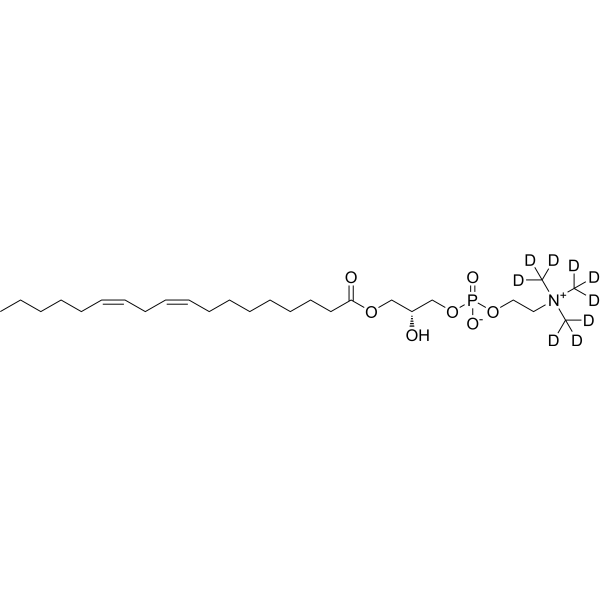
-
- HY-111254
-
|
|
PPAR
|
Metabolic Disease
|
|
GQ-16 is a moderate affinity ligand for the ligand-binding domain (LBD) of PPARγ, exhibiting a Ki of 160 nM. GQ-16 is an effective inhibitor of Cdk5-mediated phosphorylation of PPARγ. GQ-16 is a partial agonist of PPARγ with reduced adipogenic actions. GQ-16 promotes insulin Sensitization without weight gain .
|
-
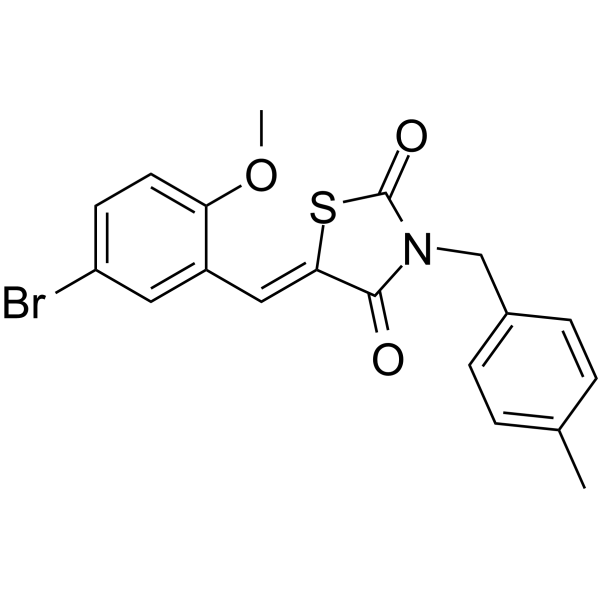
-
- HY-N2118
-
|
|
PPAR
PKA
Akt
p38 MAPK
ERK
|
Metabolic Disease
|
|
Bilobetin, an active component of Ginkgo biloba, can reduce blood lipids and improve the effects of insulin. Bilobetin ameliorated insulin resistance, increased the hepatic uptake and oxidation of lipids, reduced very-low-density lipoprotein triglyceride secretion and blood triglyceride levels, enhanced the expression and activity of enzymes involved in β-oxidation and attenuated the accumulation of triglycerides and their metabolites in tissues. Bilobetin also increased the phosphorylation, nuclear translocation and activity of PPARα accompanied by elevated cAMP level and PKA activity .
|
-
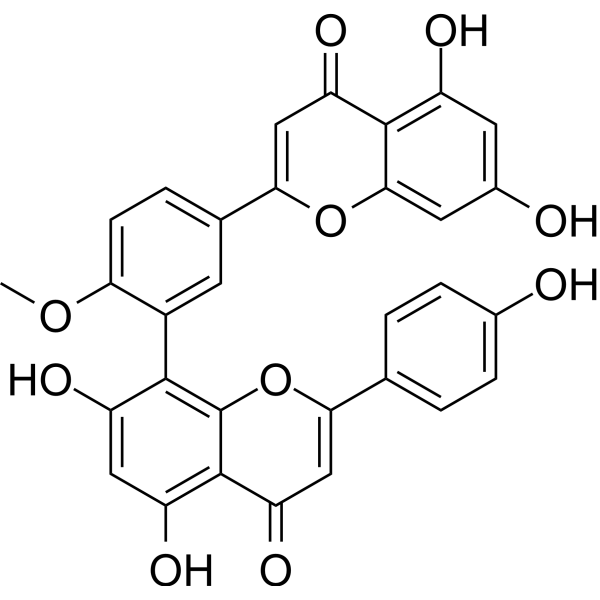
-
- HY-114196
-
|
ZGN-1061
|
MetAP
|
Metabolic Disease
|
|
Aclimostat (ZGN-1061) is a potent inhibitor of the MetAP2 enzyme and displays favorable efficacy and safety in preclinical studies. ZGN-1061 produced similar efficacy as beloranib for weight loss, improvements in metabolic parameters in a mouse model of obesity and insulin resistance, and concordant changes in gene transcription in HepG2 cells .
|
-
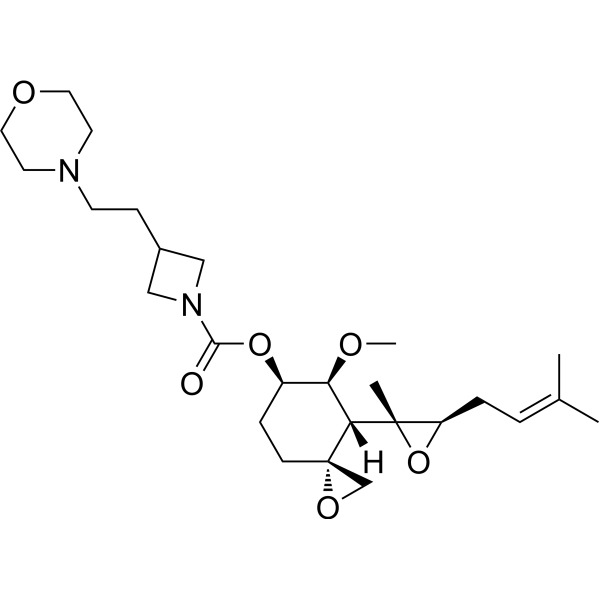
-
- HY-N6869
-
|
|
Antibiotic
PPAR
Bacterial
Fungal
|
Infection
Metabolic Disease
Inflammation/Immunology
Cancer
|
|
Dehydroabietic acid is a diterpene resin acid that can be isolated from Pinus and Picea. Dehydroabietic acid has anti-bacterial, anti-fungal, anti-inflammatory, and anticancer activities. Dehydroabietic acid is a dual PPAR-α/γ agonist and PPAR-γ partial agonist, which can attenuate insulin resistance (IR) and hepatic steatosis induced by HFD-consumption in mice .
|
-

-
- HY-151959
-
|
|
FXR
|
Cardiovascular Disease
Metabolic Disease
Inflammation/Immunology
|
|
FXR agonist 4 (compound 10a) is an agonist of farnesoid X receptor (FXR) with an EC50 value of 1.05 μM. FXR agonist 4 effectively improves hyperlipidemia, hepatic steatosis, insulin resistance and hepatic inflammation in DIO mice. FXR agonist 4 can be used for the research of non-alcoholic fatty liver disease (NAFLD) .
|
-

-
- HY-P2501
-
|
|
Amylin Receptor
|
Metabolic Disease
|
|
Amylin (8-37), human is a fragment of human Amylin. Amylin (8-37), human has direct vasodilator effects in the isolated mesenteric resistance artery of the rat. Human Amylin is a small hormone secreted by pancreatic β-cells that forms aggregates under insulin deficiency metabolic conditions, and it constitutes a pathological hallmark of type II diabetes mellitus .
|
-

-
- HY-B1245R
-
|
Salicylsalicylic acid (Standard); Disalicylic acid (Standard)
|
Reactive Oxygen Species
|
Inflammation/Immunology
|
|
Salsalate (Standard) is the analytical standard of Salsalate. This product is intended for research and analytical applications. Salsalate, a non-acetylated salicylate, is an effective antirheumatic agent that bypasses gastric absorption and also avoids cyclooxygenase inhibition. Salsalate has anti-inflammatory activity and reduces glucose levels, insulin resistance, and cytokine expression. Salsalate can be used in the research of type 2 diabetes .
|
-
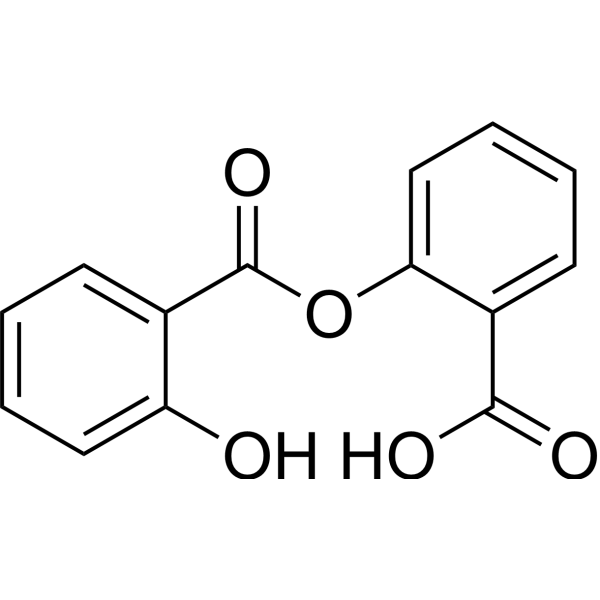
-
- HY-135337
-
|
|
Potassium Channel
|
Metabolic Disease
|
|
Ethyl tosylcarbamate is an intermediate in the synthesis of Gliclazide (G409877) . Gliclazide is a whole-cell beta-cell ATP-sensitive potassium currents blocker with an IC50 of 184 nM .
|
-
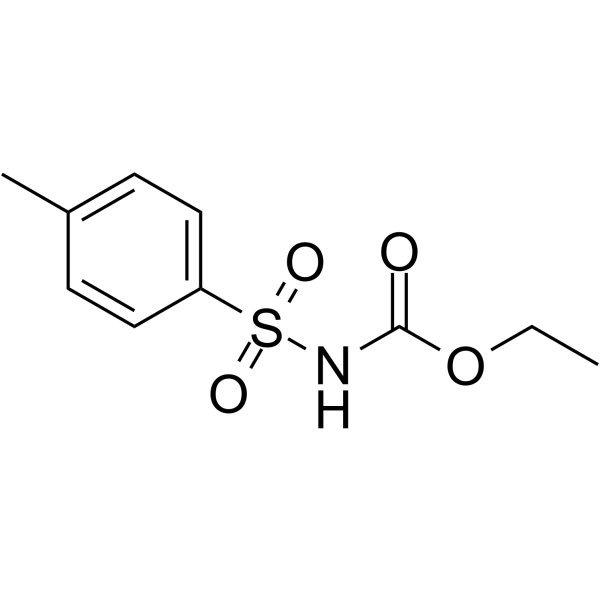
-
- HY-149971
-
|
|
FXR
|
Inflammation/Immunology
|
|
XJ02862-S2 shows potent FXR agonistic activity. XJ02862-S2 is a promising lead compound for the research of NAFLD .
|
-
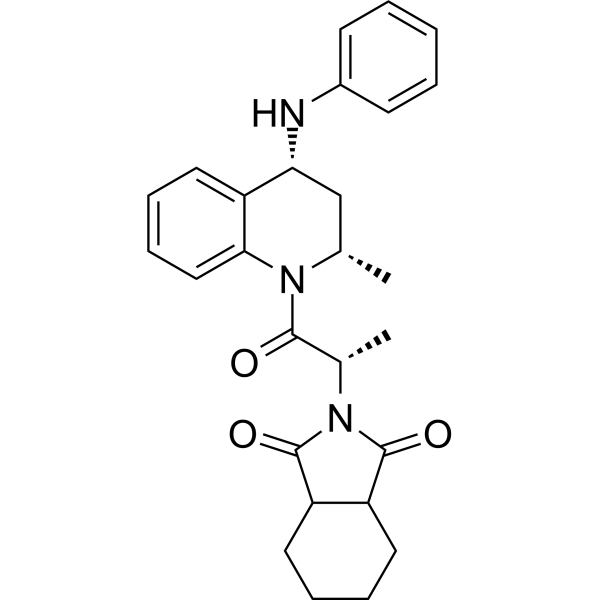
-
- HY-131334
-
|
|
AMPK
|
Metabolic Disease
|
|
AMPK activator 4 is a potent AMPK activator without inhibition of mitochondrial complex I. AMPK activator 4 selectively activates AMPK in the muscle tissues. AMPK activator 4 dose-dependently improves glucose tolerance in normal mice, and significantly lowers fasting blood glucose level and ameliorates insulin resistance in db/db diabetic mice. Anti-hyperglycemic effect .
|
-

-
- HY-N0236
-
Corylin
4 Publications Verification
|
Antibiotic
STAT
|
Infection
Metabolic Disease
Cancer
|
|
Corylin is an orally active flavonoid anti-inflammatory and osteogenic agent that inhibits IL-6-induced STAT3 promoter activity and STAT3 phosphorylation. Corylin also has anticancer, antiatherosclerotic, and ameliorating activity in hyperlipidemia and insulin resistance, inducing adipocyte browning and lipolysis through SIRT1 or β3-AR-dependent pathways .
|
-
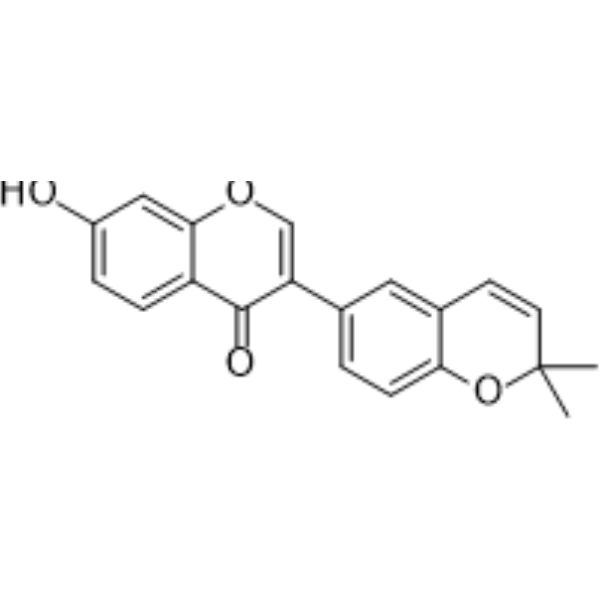
-
- HY-W011012
-
|
|
Adenosine Receptor
|
Metabolic Disease
|
|
Adenosine 5'-monophosphate disodium is an orally active purine nucleotide, and participates in ATP metabolism. Adenosine 5'-monophosphate disodium is also a ligand for adenosine 2B receptor. Adenosine 5'-monophosphate disodium can activate AMPK in skeletal muscle, and ameliorates insulin resistance and impaired glucose metabolism. Adenosine 5'-monophosphate disodium can be used for research of diabetes .
|
-
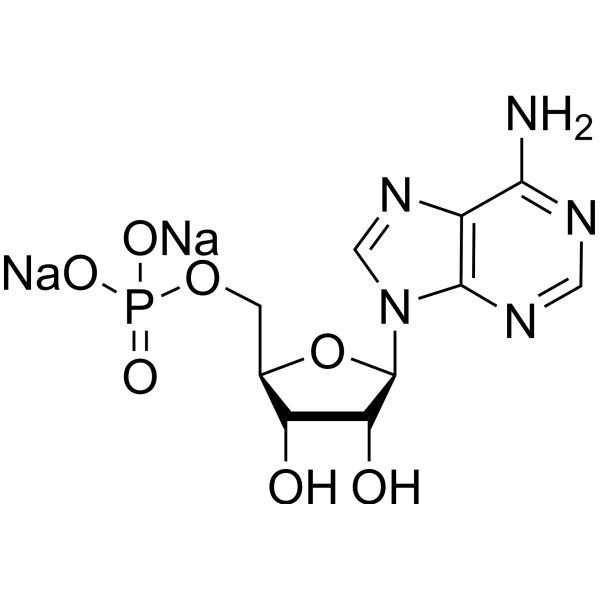
-
- HY-13991A
-
|
|
Ras
|
Metabolic Disease
Cancer
|
|
(S)-CCG-1423 is an inhibitor of Rho signaling that blocks the nuclear import of MRTF-A. (S)-CCG-1423 reduces the nuclear accumulation of MRTF-A and improves glucose uptake and tolerance in insulin-resistance mice in vivo. (S)-CCG-1423 exhibits higher inhibition activity than the SR- and the R-isomers of CCG-1423 (HY-13991). (S)-CCG-1423 can be used for the research of cancer and diabetes .
|
-
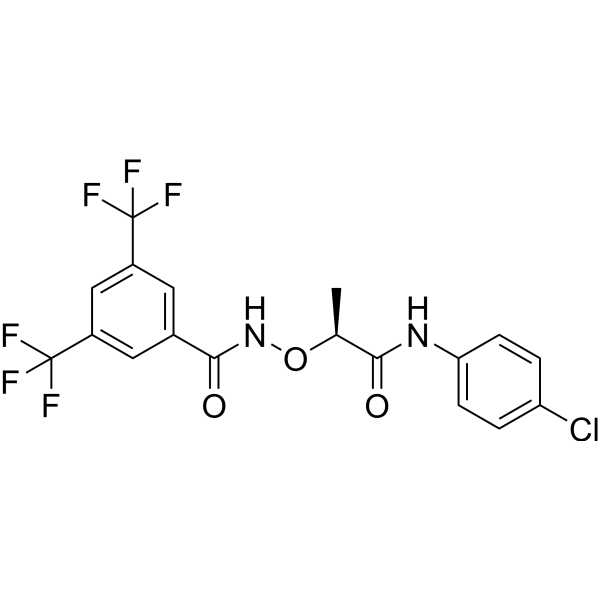
-
- HY-18555
-
TMPA
1 Publications Verification
|
Nuclear Hormone Receptor 4A/NR4A
AMPK
|
Metabolic Disease
Inflammation/Immunology
Cancer
|
|
TMPA is a high-affinity Nur77 antagonist that binds to Nur77 leading to the release and shuttling of LKB1 in the cytoplasm to activate AMPKα. TMPA effectively lowers blood glucose and attenuates insulin resistance in type II db/db, high-fat diet and streptozotocin-induced diabetic mice. TMPA reduces RICD (restimulation-induced cell death) in human T cells, can also be used in studies of cancer and T-cell apoptosis dysregulation .
|
-

-
- HY-113381
-
|
α-Hydroxybutyric acid
|
Endogenous Metabolite
|
Metabolic Disease
Inflammation/Immunology
|
|
2-Hydroxybutyric acid (α-Hydroxybutyric acid ) is converted from 2-Aminobutyric acid, with 2-oxobutyric acid as an intermediate metabolite . 2-Hydroxybutyric acid is a potential biomarker for type 2 diabetes and preeclampsia . 2-Hydroxybutyric acid prevents the acetaminophen (AP)-induced liver injury .
|
-
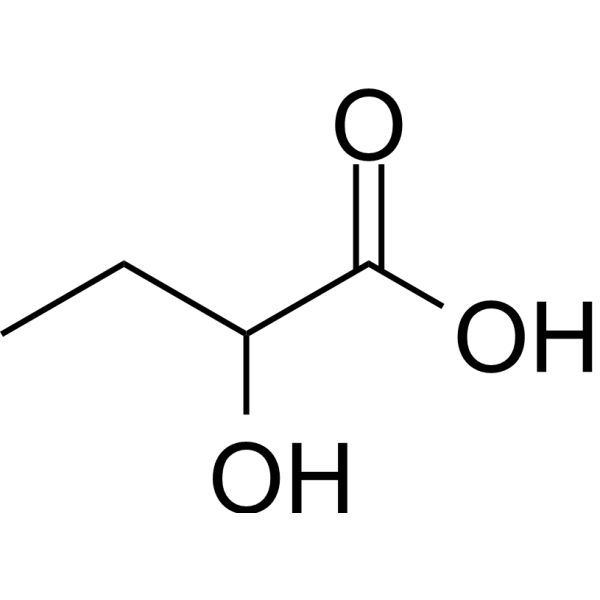
-
- HY-N7676
-
|
|
AMPK
HDAC
|
Cardiovascular Disease
Neurological Disease
Metabolic Disease
|
|
Marein has the neuroprotective effect due to a reduction of damage to mitochondria function and activation of the AMPK signal pathway. Marein improves insulin resistance induced by high glucose in HepG2 cells through CaMKK/AMPK/GLUT1 to promote glucose uptake, through IRS/Akt/GSK-3β to increase glycogen synthesis, and through Akt/FoxO1 to decrease gluconeogenesis. Marein is a HDAC inhibitor with an IC50 of 100 µM. Marein has beneficial antioxidative, antihypertensive, antihyperlipidemic and antidiabetic effects .
|
-

-
- HY-117427
-
|
|
Others
|
Metabolic Disease
|
|
D5D-IN-326 is a selective, orally active delta-5 desaturase (D5D) inhibitor, with IC50s of 72 and 22 nM for rat and human D5D in enzymic and cell-based assays, respectively, has no effect on D6D or D9D activity. D5D-IN-326 reduces insulin resistance and decreases body weight in diet-induced obese C57BL/6J mice .
|
-

-
- HY-120801
-
APX-115
1 Publications Verification
Ewha-18278
|
NADPH Oxidase
|
Metabolic Disease
Inflammation/Immunology
|
|
APX-115 (Ewha-18278) is a potent, orally active pan NADPH oxidase (Nox) inhibitor with Ki values of 1.08 μM, 0.57 μM, and 0.63 μM for Nox1, Nox2 and Nox4, respectively. APX-115 effectively prevents kidney injury .
|
-
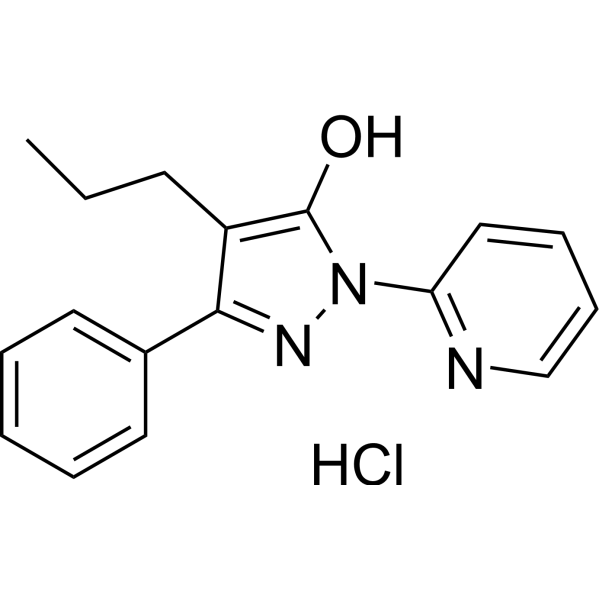
-
- HY-120801A
-
|
Ewha-18278 free base; Isuzinaxib free base
|
NADPH Oxidase
|
Inflammation/Immunology
Endocrinology
|
|
APX-115 free base (Ewha-18278 free base) is a potent, orally active pan NADPH oxidase (Nox) inhibitor with Ki values of 1.08 μM, 0.57 μM, and 0.63 μM for Nox1, Nox2 and Nox4, respectively. APX-115 free base effectively prevents kidney injury .
|
-

-
- HY-W021265
-
|
Cyclohexane-1,2,3,4,5,6-hexol
|
Biochemical Assay Reagents
|
Others
|
|
Cyclohexane-1,2,3,4,5,6-hexaol, also known as inositol or inositol, is a cyclic sugar alcohol consisting of a six-carbon ring with six hydroxyl groups. This compound is important for its biological activity and is widely distributed in nature, especially in plant and animal tissues. It plays a role in various physiological processes such as signal transduction, osmoregulation and lipid metabolism. In addition, Cyclohexane-1,2,3,4,5,6-hexaol has potential investigational effects, including improving conditions related to insulin resistance, polycystic ovary syndrome, and mental health conditions. It can also be used as a supplement in animal feed and human nutritional products.
|
-
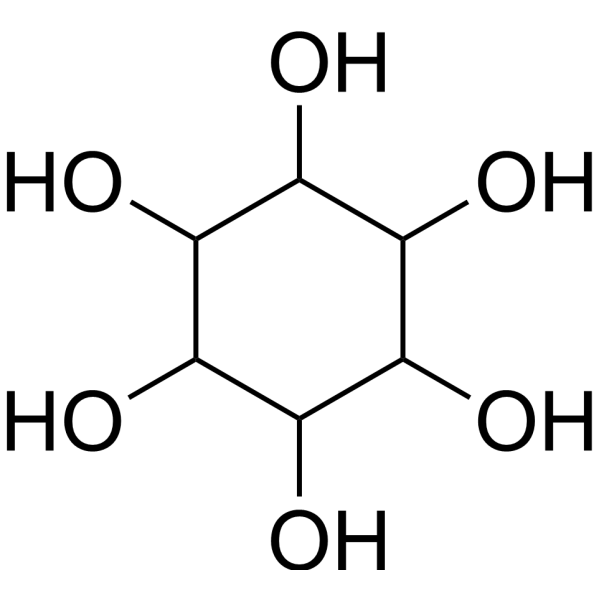
-
- HY-N2515
-
|
|
NF-κB
PI3K
JAK
Apoptosis
|
Inflammation/Immunology
Cancer
|
|
Ginsenoside Rk1 is a unique component created by processing the ginseng plant (mainly Sung Ginseng, SG) at high temperatures .
Ginsenoside Rk1 has anti-inflammatory effect, suppresses the activation of Jak2/Stat3 signaling pathway and NF-κB .
Ginsenoside Rk1 has anti-tumor effect, antiplatelet aggregation activities, anti-insulin resistance, nephroprotective effect, antimicrobial effect, cognitive function enhancement, lipid accumulation reduction and prevents osteoporosis .
Ginsenoside Rk1 induces cell apoptosis by triggering intracellular reactive oxygen species (ROS) generation and blocking PI3K/Akt pathway .
|
-

-
- HY-14393
-
Emodin
Maximum Cited Publications
17 Publications Verification
Frangula emodin
|
SARS-CoV
Casein Kinase
Autophagy
11β-HSD
|
Cancer
|
|
Emodin (Frangula emodin), an anthraquinone derivative, is an anti-SARS-CoV compound. Emodin blocks the SARS coronavirus spike protein and angiotensin-converting enzyme 2 (ACE2) interaction . Emodin inhibits casein kinase-2 (CK2). Anti-inflammatory and anticancer effects . Emodin is a potent selective 11β-HSD1 inhibitor with the IC50 of 186 and 86 nM for human and mouse 11β-HSD1, respectively. Emodin ameliorates metabolic disorder in diet-induced obese mice .
|
-

- HY-P1944A
-
|
|
Apelin Receptor (APJ)
|
Cardiovascular Disease
Metabolic Disease
|
|
Apelin-13 TFA is an endogenous ligand for the G-protein coupled receptor angiotensin II protein J (APJ), activating this G protein-coupled receptor with an EC 50 value of 0.37 nM. Apelin-13 TFA has vasodilatory and antihypertensive effects. Apelin-13 TFA also can be used for researching type 2 diabetes and metabolic syndrome .
|
-

- HY-P1944
-
|
|
Apelin Receptor (APJ)
|
Cardiovascular Disease
Metabolic Disease
|
|
Apelin-13 is an endogenous ligand for the G-protein coupled receptor angiotensin II protein J (APJ), activating this G protein-coupled receptor with an EC 50 value of 0.37 nM. Apelin-13 is widely distributed in the central and peripheral nervous systems. Apelin-13 has vasodilatory and antihypertensive effects. Apelin-13 also can be used for researching type 2 diabetes and metabolic syndrome .
|
-
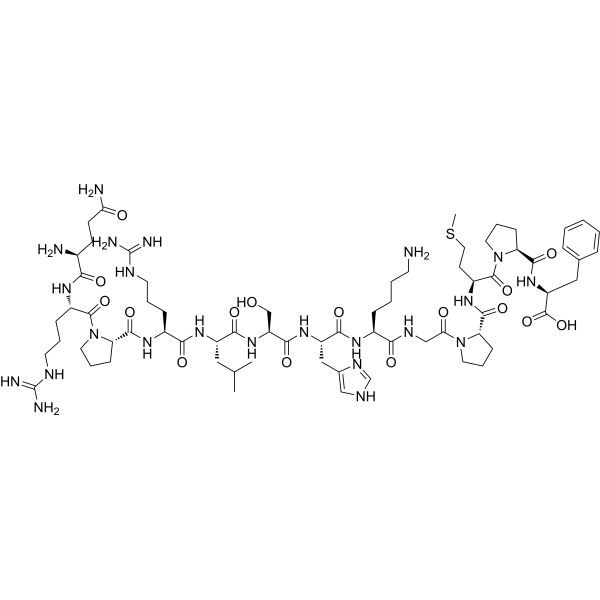
| Cat. No. |
Product Name |
Type |
-
- HY-W011012
-
|
|
Biochemical Assay Reagents
|
|
Adenosine 5'-monophosphate disodium is an orally active purine nucleotide, and participates in ATP metabolism. Adenosine 5'-monophosphate disodium is also a ligand for adenosine 2B receptor. Adenosine 5'-monophosphate disodium can activate AMPK in skeletal muscle, and ameliorates insulin resistance and impaired glucose metabolism. Adenosine 5'-monophosphate disodium can be used for research of diabetes .
|
-
- HY-W021265
-
|
Cyclohexane-1,2,3,4,5,6-hexol
|
Biochemical Assay Reagents
|
|
Cyclohexane-1,2,3,4,5,6-hexaol, also known as inositol or inositol, is a cyclic sugar alcohol consisting of a six-carbon ring with six hydroxyl groups. This compound is important for its biological activity and is widely distributed in nature, especially in plant and animal tissues. It plays a role in various physiological processes such as signal transduction, osmoregulation and lipid metabolism. In addition, Cyclohexane-1,2,3,4,5,6-hexaol has potential investigational effects, including improving conditions related to insulin resistance, polycystic ovary syndrome, and mental health conditions. It can also be used as a supplement in animal feed and human nutritional products.
|
| Cat. No. |
Product Name |
Target |
Research Area |
-
- HY-P3580A
-
|
Human N-acetyl GIP TFA
|
Insulin Receptor
|
Metabolic Disease
Endocrinology
|
|
Acetyl Gastric Inhibitory Peptide (human) TFA is a fatty acid derivatized analog of glucose-dependent insulinotropic polypeptide with improved antihyperglycaemic and insulinotropic properties. Acetyl Gastric Inhibitory Peptide (human) TFA can be used for research of diabetes, insulin resistance and obesity .
|
-
- HY-P3848
-
|
|
Peptides
|
Neurological Disease
Metabolic Disease
|
|
Tyr0-Neurokinin A is a neuropeptide belongs to tachykinin peptide family. Tyr0-Neurokinin A is an agonist of Tacr2. Tyr0-Neurokinin A can be used in the research of insulin resistance, obesity, diabetes .
|
-
- HY-P3580
-
|
Human N-acetyl GIP
|
Insulin Receptor
|
Metabolic Disease
Endocrinology
|
|
Acetyl Gastric Inhibitory Peptide (human) is a fatty acid derivatized analog of glucose-dependent insulinotropic polypeptide with improved antihyperglycaemic and insulinotropic properties. Acetyl Gastric Inhibitory Peptide (human) can be used for research of diabetes, insulin resistance and obesity .
|
-
- HY-P3866
-
|
|
Peptides
|
Metabolic Disease
|
|
[Asu1,6]-Oxytocin is an analog of oxytocin. [Asu1,6]-Oxytocin reverses insulin resistance and glucose intolerance prior to reduction of obesity. [Asu1,6]-Oxytocin has the potential for the research of obesity and diabetes .
|
-
- HY-P2501
-
|
|
Amylin Receptor
|
Metabolic Disease
|
|
Amylin (8-37), human is a fragment of human Amylin. Amylin (8-37), human has direct vasodilator effects in the isolated mesenteric resistance artery of the rat. Human Amylin is a small hormone secreted by pancreatic β-cells that forms aggregates under insulin deficiency metabolic conditions, and it constitutes a pathological hallmark of type II diabetes mellitus .
|
-
- HY-P2048
-
|
|
Peptides
|
Others
|
|
MOTS-c (human) is a biological active peptide. (Recent advances in high-resolution sequencing have led to the discovery of unique peptides derived from mitochondrial genome.1-2 Currently 8 peptides are identified: humanin, mitochondrial open reading frame of the 12S tRNA-c (MOTS-c), and six small humanin-like peptides (SHLP1-6). 1-2 All of these peptides are released into cytosol from mitochondria and associate with increased longevity and cell viability, reduced apoptosis, and other beneficial functions. 1-3 MOTS-c was found to reduce insulin resistance, decrease obesity, and promote homeostasis.)
|
-
- HY-P1944A
-
|
|
Apelin Receptor (APJ)
|
Cardiovascular Disease
Metabolic Disease
|
|
Apelin-13 TFA is an endogenous ligand for the G-protein coupled receptor angiotensin II protein J (APJ), activating this G protein-coupled receptor with an EC 50 value of 0.37 nM. Apelin-13 TFA has vasodilatory and antihypertensive effects. Apelin-13 TFA also can be used for researching type 2 diabetes and metabolic syndrome .
|
-
- HY-P1944
-
|
|
Apelin Receptor (APJ)
|
Cardiovascular Disease
Metabolic Disease
|
|
Apelin-13 is an endogenous ligand for the G-protein coupled receptor angiotensin II protein J (APJ), activating this G protein-coupled receptor with an EC 50 value of 0.37 nM. Apelin-13 is widely distributed in the central and peripheral nervous systems. Apelin-13 has vasodilatory and antihypertensive effects. Apelin-13 also can be used for researching type 2 diabetes and metabolic syndrome .
|
| Cat. No. |
Product Name |
Category |
Target |
Chemical Structure |
| Cat. No. |
Product Name |
Chemical Structure |
-
- HY-100713S
-
|
|
|
Temocapril-d5 is the deuterium labeled Temocapril. Temocapril is an angiotensin-converting enzyme (ACE) inhibitor. Temocapril hydrochloride can be used for the research of hypertension, congestive heart failure, acute myocardial infarction, insulin resistance, and renal diseases[1][2].
|
-

-
- HY-N9410S
-
|
|
|
Lysophosphatidylcholine 18:2-d9 is deuterium labeled Lysophosphatidylcholine 18:2. Lysophosphatidylcholine 18:2 (1-Linoleoyl-2-Hydroxy-sn-glycero-3-PC), a lysophospholipid, is a potential biomarker identified from insulin resistance (IR) polycystic ovary
|
-

Your information is safe with us. * Required Fields.
Inquiry Information
- Product Name:
- Cat. No.:
- Quantity:
- MCE Japan Authorized Agent:




























































